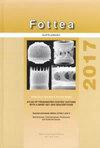Luticola rojkoviensis sp. nov. (Bacillariophyta), a new terrestrial diatom from Central Slovakia
IF 1.4
3区 生物学
Q3 PLANT SCIENCES
引用次数: 5
Abstract
Sampling of fungi in a grassland on a hill in Rojkov, Central Slovakia, revealed a new species of Luticola (Diadesmidaceae). Its terrestrial populations were found close to the basis of the fertile part of the geoglossoid fungi (Geoglossaceae) that were overgrown with filamentous cyanobacteria of the orders Oscillatoriales and Synechococcales. Luticola rojkoviensis sp. nov. is characterized by the valve outline and the structure of the external valve face: valves are weakly dorsiventrally asymmetrical, rhombic-lanceolate in larger cells to rhombic-elliptic and tri-undulate in smaller cells, with shortly protracted and broadly rounded valve apices. Valve face is minimally concave, as the axial area is lowered and the area around distal raphe elevated. The surface of the valve is mostly uneven due to many depressions, so the external shape of the areolae and the impression of irregular longitudinal rows depend on the extent of these valve ornamentations. Proximal raphe endings are unilaterally slightly deflected, expanded into small central pores. The shape of both the proximal and the distal raphe fissures is slightly asymmetrical. The morphological characteristics of Luticola rojkoviensis sp. nov. are remarkably similar to those of L. hustedtii Levkov, Metzeltin et A.Pavlov, L. ectorii Levkov, Metzeltin et A.Pavlov and L. acidoclinata Lange-Bertalot. The association of Luticola rojkoviensis sp. nov. with geoglossoid fungi and epiphytic cyanobacteria is discussed.斯洛伐克中部陆生硅藻新种Luticola rojkoviensis sp. 11 .(硅藻门)
在斯洛伐克中部Rojkov的一个小山上的草地上对真菌进行采样,发现了一种新的Luticola (Diadesmidaceae)。它的陆地种群被发现接近地舌菌(地舌菌科)的肥沃部分的基础,那里长满了丝状蓝藻目的摆动目和聚藻目。Luticola rojkoviensis sp. 11 .的特征是阀外形和外阀面结构:阀弱背侧不对称,大细胞的阀形为菱形披针形,小细胞的阀形为菱形椭圆形,三波状,阀尖短而宽而圆。由于轴向区域降低,中缝周围区域升高,阀面最小凹。由于有许多凹陷,瓣膜表面大多凹凸不平,因此乳晕的外部形状和不规则纵排的印象取决于这些瓣膜纹饰的程度。近端中缝末端单侧稍偏转,扩大成小的中央孔。中缝近端和远端裂缝的形状都略有不对称。Luticola rojkoviensis sp. 11 .的形态特征与L. hustedtii Levkov, Metzeltin et A.Pavlov, L. ectorii Levkov, Metzeltin et A.Pavlov和L. acidoclinata lue - bertalot的形态特征非常相似。讨论了Luticola rojkoviensis sp. 11与地红真菌和附生蓝藻的关联。
本文章由计算机程序翻译,如有差异,请以英文原文为准。
求助全文
约1分钟内获得全文
求助全文
来源期刊

Fottea
生物-植物科学
CiteScore
4.00
自引率
9.10%
发文量
20
审稿时长
>12 weeks
期刊介绍:
Fottea is a journal of Czech Phycological Society (formerly bulletin Czech Phycology). Fottea publishes papers on all aspects of the ecology, physiology, biochemistry, cell biology, molecular biology, systematics and uses of algae (including cyanobacteria)
 求助内容:
求助内容: 应助结果提醒方式:
应助结果提醒方式:


